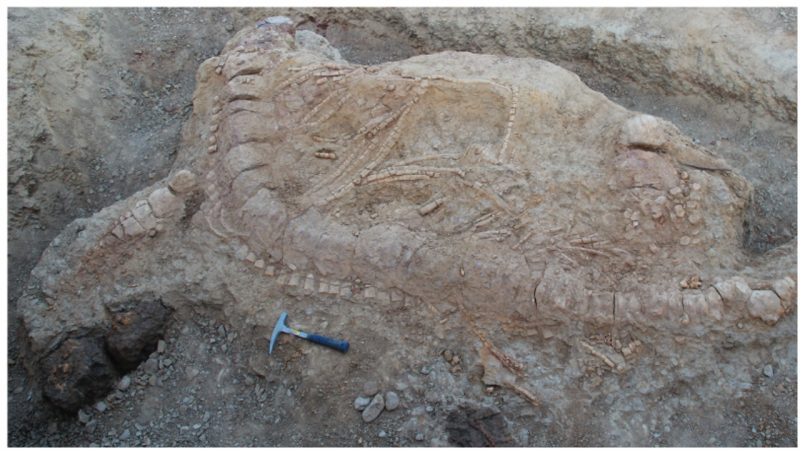Paleontologists keep discovering remains of creatures that lived in the Jurassic era, which was 199 to 145 million years ago. But the recent unearthing of a particular ichthyosaur, a sea creature, has the science world buzzing, both because of the site’s location, India, and the creature’s condition, which is of an almost completely intact skeleton. Both are rare.
Indian paleontologists found the skeleton south of Lodai, a village in India’s western Gujarat province, in 2016. It was a grueling challenge to excavate the bones, because they were encased in dense, sedimentary rock. The workers had to extract the skeleton in 100-degree heat.
These types of bones have usually been found in the Northern Hemisphere. “Vertebrate fossils are rare from the Kachchh region, and we were expecting only bone fragments from this area,” Guntupalli V.R. Prasad, a researcher who participated in the excavation, told PLOS News. “So to find a near-complete skeleton is surprising as well as exciting.”
The scientists’ study of the ichthyosaur, detailed in a journal article published on October 25, 2017, reveals a sea monster patrolling dark seas that possessed ferocious skills, one that could prompt extreme fear were it to have appeared in Jurassic Park, Steven Spielberg’s film of the Michael Crichton classic of cloned dinosaurs run amok.
The ichthyosaur skeleton led scientists to the conclusion of an adult length of 16 feet. The species is from a “highly successful group of marine reptiles,” according to the study. “Although India hosts extensive marine Jurassic deposits both in the Himalayan and peninsular Indian (Kachchh, Jaisalmer) regions, until now no ichthyosaur remains have been documented from this time interval.” A massive seaway is believed to have once existed through land now covering India, Madagascar, and South America.
Some of the teeth discovered are in “very robust” condition, the study says. Based on tooth analysis, the ichthyosaur fed on “abrasive food that may include bone.” The creature’s diet consisted of fellow creatures of “hard exterior, such as armored fish, crustaceans and thick-shelled ammonites.”
The study authors say, “The animal was feeding on a very hard, abrasive prey and might have been a top-tier predator.” Or as National Geographic put it: “These animals were the dolphins or whales of their time: svelte fish eaters with huge eyes, narrow jaws, and cone-shaped teeth.” Steve Brusatte, a paleontologist at the University of Edinburgh, said, “This new skeleton has the potential to reveal many secrets about ichthyosaur evolution and biogeography.”
The find was made during an ordinary field campaign in January and February of 2016. Scientists who were astonished to find a sea creature in India now believe that part of the reason is that no one was looking. According to the study, “The relative scarcity of marine reptiles from the Jurassic deposits of India seems to be an artifact of sampling bias rather than of preservation potential of the fossils as these marine sequences have not been prospected in the past with a focused objective of recovering vertebrate fossils.”
To excavate the skeleton, embedded in hard rock, took 1,500 hours of digging. The ichthyosaur’s backbone was still in a continuous line after at least 145 million years, and one of its forefins had retained its shape. Its state of preservation indicates that the animal landed on the sea floor vertically on its snout, while the rest of the body later fell on its side.
“This helps to show how globally widespread ichthyosaurs were during the time of the dinosaurs,” Brusatte told National Geographic. “They seem to have lived everywhere in the oceans, all over the world, at the same time as the dinosaurs were thundering across the land.”
The ichthyosaur became extinct in the Late Cretaceous era, but no one knows why.
Prasad said the team plans to intensify its field exploration in the Kachchh region. Perhaps more ichthyosaur fossils and other marine reptiles will come to light.
